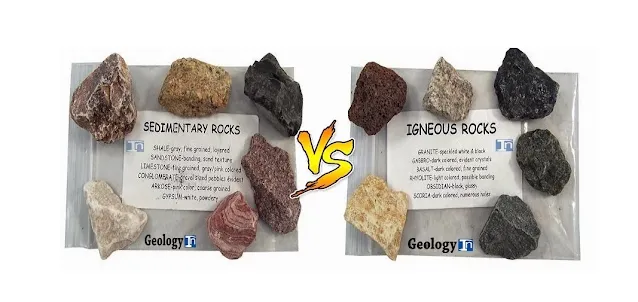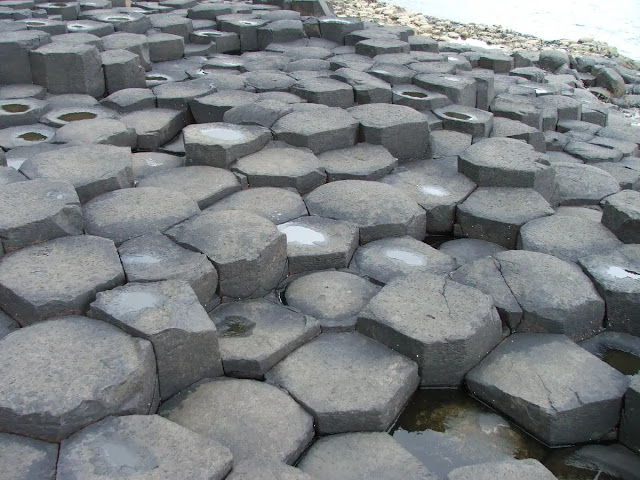The Differences Between Sedimentary and Igneous Rocks
Differences Between Sedimentary Rocks and Igneous Rocks
Sedimentary rocks and igneous rocks are two of the main types of rocks that form through different processes and under different conditions. Their characteristics, origin, and formation provide insights into the Earth's history and geological processes. Below are the detailed differences between these two rock types:
 |
A comparison of sedimentary and igneous rocks, highlighting their key characteristics and contrasting formation processes. |
Sedimentary and Igneous Rocks Formation Process
Sedimentary Rocks:
- Formed by the accumulation and lithification of sediments: These sediments are derived from pre-existing rocks (igneous, metamorphic, or other sedimentary rocks) that have been weathered, eroded, and transported by water, wind, or ice.
- Compaction and Cementation: Over time, layers of deposited sediments are compacted under pressure and cemented together by minerals precipitated from groundwater.
- Biological and Chemical Processes: Some sedimentary rocks form through biological activity (e.g., limestone from shells or corals) or chemical precipitation (e.g., rock salt from evaporating water).
Igneous Rocks:
Igneous rock: Formed from the cooling and solidification of molten magma or lava: Igneous rocks originate when magma (molten rock beneath the Earth’s surface) cools and crystallizes underground (forming intrusive/plutonic rocks) or when lava (magma that reaches the surface) cools rapidly at the surface (forming extrusive/volcanic rocks).
Distribution: Abundance on the Earth Crust
Sedimentary rocks are the most common type of rock on Earth's surface. They cover about 75% of the Earth's land area. The sedimentary rock cover of the continents of the Earth's crust is extensive, but the total contribution of sedimentary rocks is estimated to be only 8% of the total volume of the crust. Igneous and metamorphic rocks make up 90–95% of the top 16 km of the Earth's crust by volume.
Igneous Rocks: Igneous rocks are less abundant on the Earth's surface compared to sedimentary rocks but can still be found in various locations. They are often associated with volcanic activity, mid-ocean ridges, and areas of tectonic activity.
Texture
Sedimentary Rocks:
- Clastic Texture: Consist of fragments or clasts of other rocks, such as in sandstone, where individual grains of sand are cemented together.
- Layering or Stratification: Sedimentary rocks are often characterized by visible layers (strata), reflecting the different stages of sediment deposition.
- Grain Size Variation: Ranges from very fine (shale) to coarse (conglomerate) depending on the energy of the environment where the sediments were deposited.
Igneous Rocks:
- Crystalline Texture: Composed of interlocking mineral crystals that form as the magma or lava cools and solidifies. The texture depends on the rate of cooling.
- Fine-Grained (Aphanitic): Extrusive igneous rocks (e.g., basalt) have small crystals due to rapid cooling.
- Coarse-Grained (Phaneritic): Intrusive igneous rocks (e.g., granite) have larger crystals because they cool slowly below the Earth’s surface.
- Glassy or Vesicular Texture: Some extrusive igneous rocks (e.g., obsidian, pumice) cool so quickly that crystals do not form, or gas bubbles create vesicles.
Mineral Composition
Sedimentary Rocks:
The composition depends on the source material of the sediments and the environment where the rock formed. Sedimentary rocks often contain minerals like:
- Quartz: Common in sandstone.
- Calcite: Found in limestone, which forms from the accumulation of biological material or chemical precipitation.
- Clay minerals: Common in shale.
- Organic materials like plant remains (in coal) or fossils (in limestone) may also be present, reflecting biological activity in the depositional environment.
Igneous Rocks:
Igneous rocks are typically composed of silicate minerals that crystallize from magma or lava. The specific mineral composition depends on the chemical makeup of the molten material.
- Felsic rocks (rich in silica): Contain minerals like quartz, feldspar, and mica (e.g., granite).
- Mafic rocks (low in silica, high in iron and magnesium): Contain minerals like pyroxene, olivine, and plagioclase (e.g., basalt).
Fossils
Sedimentary Rocks: Often contain fossils of plants and animals that were buried in the sediments over time. These fossils provide valuable information about past life forms and environmental conditions. Fossils can be preserved in sedimentary rocks due to the processes of sedimentation and lithification (the process of sediment transforming into rock).
Igneous Rocks: Almost never contain fossils because the high temperatures associated with molten magma would destroy any organic material present.
Sedimentary and Igneous Rocks Structures
Sedimentary rocks can have a variety of structures, such as bedding, ripple marks, and cross-bedding. Structures in sedimentary rocks can be divided into 'primary' structures (formed during deposition) and 'secondary' structures (formed after deposition). Structures are always large-scale features that can easily be studied in the field.
Igneous rocks can also exhibit a variety of structures, such as vesicles, amygdules, and columnar jointing. These structures are formed by the processes of cooling and solidification. The structures of igneous rocks are large scale features, which are dependent on several factors like: (a) Composition of magma. (b) Viscosity of magma. (c) Temperature and pressure at which cooling and consolidation takes place. (d) Presence of gases and other volatiles.
Classification and Types
Sedimentary rocks are classified into three main types: clastic, chemical, and organic. Clastic sedimentary rocks are formed from fragments of pre-existing rocks. Chemical sedimentary rocks are created by the precipitation of minerals from water. Organic sedimentary rocks originate from biological materials.
Igneous rocks are divided based on their formation location into extrusive (volcanic) and intrusive (plutonic) types. Extrusive igneous rocks are formed when lava cools quickly on the surface, while intrusive igneous rocks result from the slow cooling of magma underground. These classifications reflect the different processes involved in their formation and the materials from which they are derived.
Geological Setting
Sedimentary Rocks: Sedimentary rocks form in a wide range of geological settings, including river valleys, lake beds, coastal areas, and continental shelves. They are associated with processes such as weathering, erosion, transportation, deposition, compaction, and cementation.
Igneous Rocks: Igneous rocks form in various geological settings, including volcanic areas, mid-ocean ridges, and areas of tectonic activity where magma intrudes into the Earth's crust. They are associated with processes such as melting, magma ascent, and cooling.
Hardness
Sedimentary Rocks: Generally weaker and less hard compared to igneous rocks because they are formed from the compaction and cementation of often loose sediments. However, their hardness can vary depending on the mineral composition and the degree of cementation.
Igneous Rocks: Generally harder and more durable due to the crystallization of minerals from molten rock. Their hardness can also vary depending on the mineral composition and the rate of cooling and crystallization.
Importance and Uses
Sedimentary rocks are used in a variety of ways, including construction materials, abrasives, and chemicals. Sedimentary rocks are also used to produce fossil fuels, such as coal and oil. Coal and oil shale are found in sedimentary rocks. A large proportion of the world's uranium energy resources are hosted within sedimentary successions.sedimentary rocks contain a large proportion of the Earth's groundwater aquifers. Our understanding of the extent of these aquifers and how much water can be withdrawn from them depends critically on our knowledge of the rocks that hold them (the reservoir).
Many types of igneous rocks are used as building stone, facing stone, and decorative material, such as that used for tabletops, cutting boards, and carved figures. Pumice is used as an abrasive material in hand soaps, emery boards, etc.
Understanding these key differences will help you differentiate between sedimentary and igneous rocks and gain a deeper understanding of the geological processes that shape our planet.
Read also: The Differences between Metamorphic rocks and Igneous rocks
The Differences Between Sedimentary and Metamorphic Rocks




%20(1).webp)




